The Patent Trial and Appeal Board is an important forum for determining patentability.
In inter partes review and post grant review proceedings, the institution decision represents the board's first determination of the strength of a petition and is a crucial milestone that can terminate the proceeding entirely.
There are many reasons why the board might deny institution of a petition and, although merits-based denials are the most common, procedural denials, a petitioner's failure to meet a statutory requirement, or other reasons unrelated to the merits are not infrequent.
Understanding the reasons why recent petitions have been denied can provide insight to both petitioners and patent owners in future proceedings.
In this article, we will analyze the board's denials of institution for the one-year period between May 22, 2023, and May 21, 2024.12
Overview of Denials
During the time period analyzed, the board issued a total of about 1,022 IPR and PGR institution decisions.
Of these, 665, or 65%, of petitions were instituted and 357, or 35%, of petitions were denied. This number appears to generally track the U.S. Patent and Trademark Office's own data from May that showed a roughly 66% institution rate for the first half of financial year 2024, between Oct. 1, 2023, and May 31.3
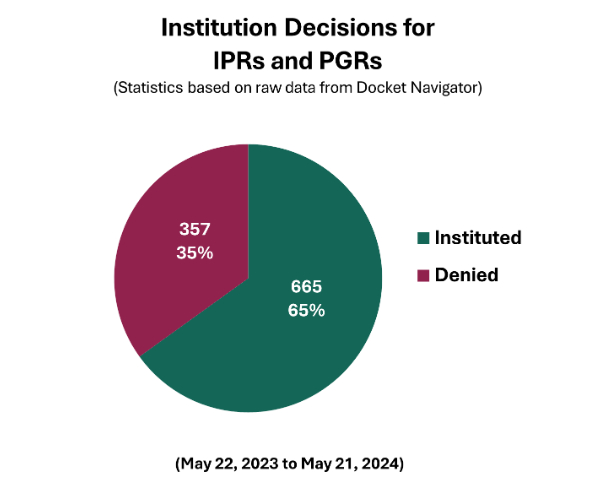
Breaking down these denials by technology area reveals that the 265 denials related to electrical and computer patents accounted for the majority of denials, followed by pharma/bio patents with 41 denials, mechanical patents with 36 denials, chemical patents with 11 denials and design patents with four denials.
It is possible that the large number of electrical and computer-related petitions, compared to other technology fields, accounts for these differences.4
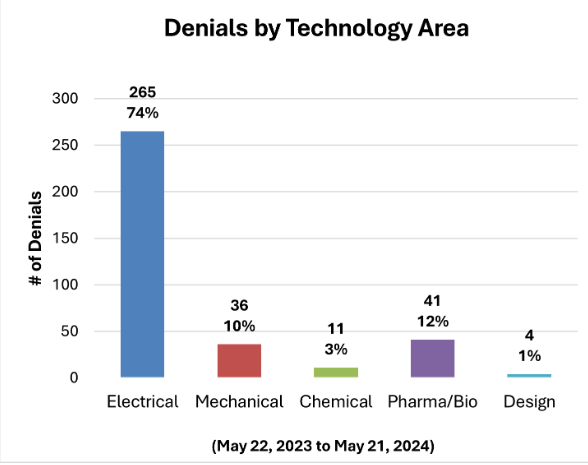
Fintiv Stipulations
When there is a parallel district court litigation, the board may consider various factors under 2020′s Apple Inc. v. Fintiv Inc. to assess whether to discretionarily deny institution.5
To mitigate the possibility of a discretionary denial under Fintiv, petitioners may file stipulations stating that, if the board institutes review, the petitioner will not pursue certain grounds of invalidity in the parallel litigation. Broadly speaking, these stipulations come in three categories:
- Sand Revolution stipulations, from Sand Revolution II LLC v. Continental Intermodal Group –– Trucking LLC in 2020, where the petitioner stipulates that, if review is instituted, the petitioner will not pursue the same instituted grounds in the parallel proceeding;6
- Sotera stipulations, from Sotera Wireless Inc. v. Masimo Corp. in 2020, where the petitioner stipulates that, if review is instituted, the petitioner will not pursue any grounds that were raised in the petition or that could have reasonably been raised in the instituted petition, in the parallel proceeding;7 and
- Intermediate stipulations, which fall somewhere between Sand Revolution and Sotera stipulations.
One example of an intermediate stipulation is where the petitioner stipulates that, if review is instituted, the petitioner will not pursue the primary references asserted in the petition in the parallel litigation.8
Of the 357 proceedings that were denied institution, 148, or 42%, of denied petitions did not include any Fintiv stipulation; 61 petitions, or 17%, included a Sand Revolution stipulation; 118 petitions, or 33%, included a Sotera stipulation; and 30 petitions, or 8%, included a stipulation other than Sotera or Sand Revolution.
Although submitting a stipulation may mitigate Fintiv considerations to varying degrees, when the board has denied institution, only 19 of the denials, or 5%, were based on Fintiv. The remaining denials were based on another reason, and the board would sometimes note that it need not consider Fintiv when it denied institution for other reasons.
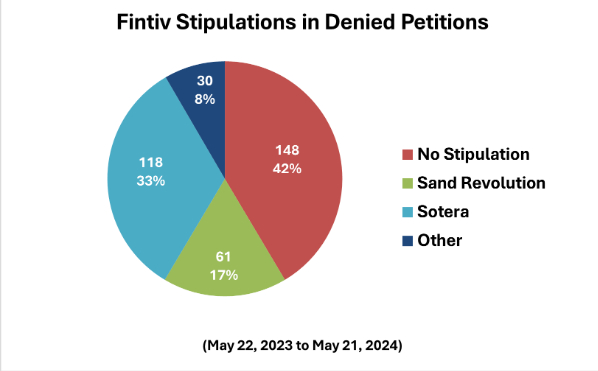
Reasons for Denial
The board's reasons for denial were categorized into eight groups:
1. Failure to show obviousness;
2. Failure to show anticipation;
3. An asserted reference was not shown to be prior art;
4. Claim construction;
5. Discretionary denial under Fintiv;
6. Discretionary denial based on previously considered art or
arguments under Section 325(d);
7. Disclaimer of the challenged claims by the patent owner;
and
8. Other reasons not encompassed by the preceding categories, such
as serial petitions.
The chart below shows how many denial decisions relied on each of these reasons.
As shown below, the vast majority of denials were merits-based, with almost two-thirds of the decisions — 228 decisions or 64% —9 finding that the petition failed to establish obviousness, followed by failure to show anticipation, or 49 decisions or 14%.
A claim construction determination, whether the patent owner's construction or the board's own construction, was dispositive in 30 decisions (8%).10 Interestingly, a petitioner's failure to establish that a reference was prior art factored into 30 decisions (8%).
Fintiv denials accounted for only 19 decisions, or 5%, but, as noted above, the board sometimes declined to consider Fintiv when it found another basis for denial.
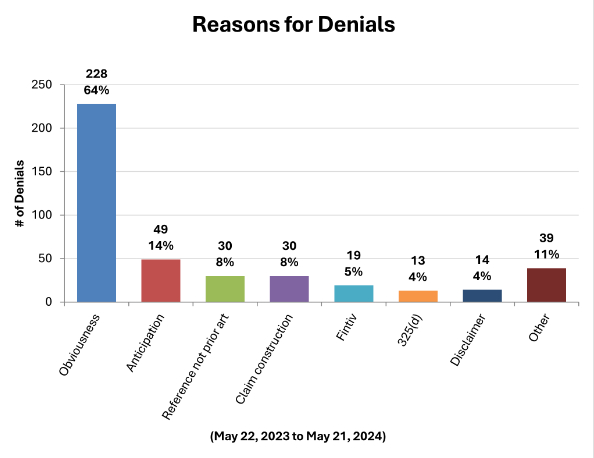
Within the obviousness-based denials, a petitioner's failure to show that the prior art disclosed a particular claim element11 was the most frequent reason for denial, being identified in 151 decisions, or 66%; followed by a failure to establish a motivation to combine teachings in 98 decisions, or 43%; failure to show an expectation of success in making a combination in 17 decisions, or 7%; and insufficient evidence to overcome secondary considerations of nonobviousness in two decisions, or 1%.
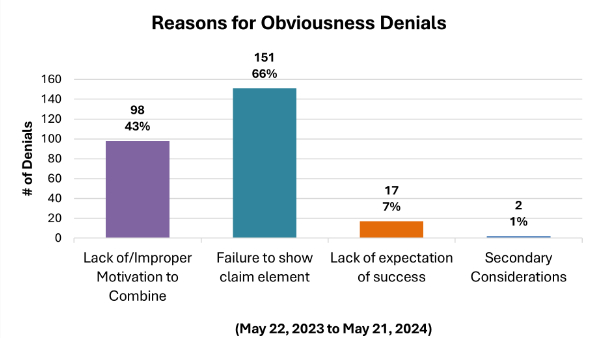
For denial decisions finding a failure to show anticipation, the vast majority, 46 decisions, or 94%, were based on a petitioner's failure to show a claim element in the prior art, while four decisions, or 8%, found a failure to show inherency of a limitation.
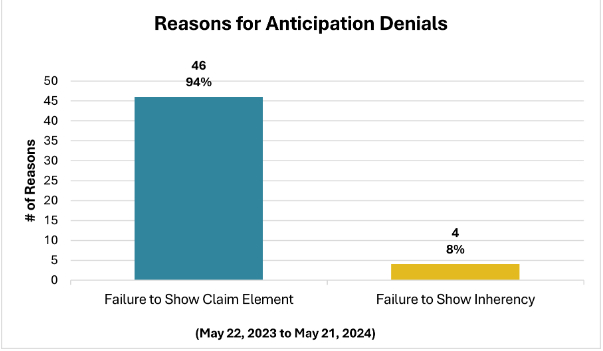
Although the board provided an express claim construction in only about 8% of the denial decisions, the decisions were almost evenly split between the board agreeing with a patent owner's construction — 16 decisions or 53% — and relying on its own construction, with 14 decisions or 47%.
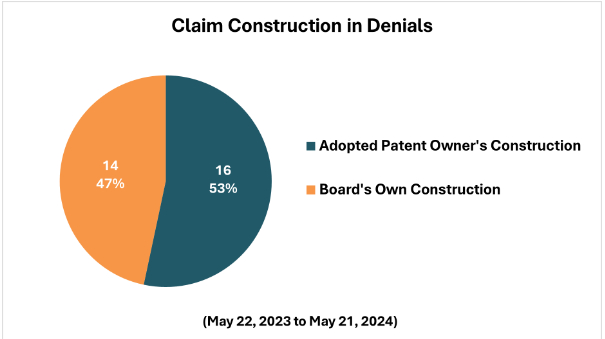
Other notable reasons for denying institution included a petitioner's failure to show the asserted reference was prior art under Section 102, in 22 decisions or 6%; discretionary denial under Fintiv, in 19 decisions or 5%; discretionary denial under Section 325(d) because the USPTO had already considered the same art or arguments, in 13 decisions or 4%; and the patent owner disclaiming the challenged claims, in 14 decisions or 4%.
Observations
Whether the petition was based on anticipation or obviousness, a petitioner's failure to show that a claim element was disclosed by the prior art was the most common reason for denying any petition.
But, nearly half, or 43%, of the obviousness-related denials were denied because the petitioner failed to show a motivation to combine the references or modify the primary reference.
These two data points can show where petitioners can strengthen their petitions' arguments and areas that patent owners can consider to attack a particular petition.
The board's decision in Safe Haven Wildlife Removal and Property Management Experts LLC v. Meridian Wildlife Services LLC in February provides one example.12
The board denied institution, finding the petitioner's rationale for combining references' teachings insufficient because it did not explain why it would have been obvious to have poles for netting "sitting on the floor," as claimed, when the prior art described the poles as positioned "in the ground."13
The board also found that, although the petitioner argued that "there [was] no material difference between [using] hooks and magnetic connectors" to attach the netting poles to a ceiling, "there [was] no explanation or evidence regarding the differences between attachment by a magnetic head that requires a flat bottom surface comprised of a magnetic material and a hook that does not require either of these things."14
The board also noted some structural differences between magnetic heads and hooks and found that the petitioner had not provided adequate evidence supporting the proposed combination to replace one with the other.15
In another example, Current Lighting Solutions LLC dba GE Current v. Jiaxing Super Lighting Electric Appliance Co. Ltd. in May 2022,16 the board found that the petitioner failed to show obviousness because the petition relied on "certain spatial relationships" in a prior art figure, but the figure showed "a 'schematic circuit diagram,' not a representation of [a] lamp components' spatial arrangement."17
The board explained that "neither Petitioner nor [its expert] explain[ed] why a person of ordinary skill in the art would have read the disclosed electrical relationships as teaching component locations to arrive at the particular spatial arrangement required by the claim."18
Procedural requirements may provide bases for denial without ever reaching the merits of the asserted references. For example, when the petitioner did not establish that a reference was prior art, the board found that the petitioner failed to show that it was publicly available in eight decisions, or 2%, or did not satisfy other criteria to be prior art under Section 102, such as showing priority to a provisional application, 22 decisions or 6%.
And at least one patent owner successfully removed a reference as prior art by swearing behind the asserted reference.19
In one example, Apple Inc. v. DoDots Licensing Solutions LLC last December,20 the board found that Apple failed to show that appendices filed with a prior art patent were prior art.
The board found that, although the appendices were filed with the patent's specification and were referred to as attached by the patent, they were not published with the patent or incorporated by reference, and therefore did not qualify as part of the prior art under Section 102(e).21
By understanding the board's common reasons for denial, practitioners can more effectively draft petitions or argue against them, thereby increasing their chances of securing a favorable outcome for their clients.
Footnotes
1 This article looks only at decisions denying institution and excludes decisions that were later instituted on rehearing and rehearing requests affirming a previous denial decision.
2 The list of denials was generated using Docket Navigator and decisions were manually reviewed. While we have attempted to be as accurate as possible, it is possible that some data was not captured. Therefore, the results should be viewed as informative trends, rather than absolute values.
3 https://www.uspto.gov/sites/default/files/documents/ptab_aia_20240531.pdf.
4 The USPTO notes that 514 institution decisions were issued for electrical-related patents, while the next closest category—mechanical and business method patents—had only 156 institution decisions issued. https://www.uspto.gov/sites/default/files/documents/ptab_aia_20240531.pdf. In our analysis, business methods were grouped with electrical or mechanical decisions category, depending on which field they most closely related to.
5 Apple Inc. v. Fintiv Inc., IPR2020-00019, Paper 11 at 6 (PTAB Mar. 20, 2020) (precedential). These factors include: (1) whether the court granted a stay or evidence exists that one may be granted if a proceeding is instituted; (2) proximity of the court's trial date to the Board's projected statutory deadline for a final written decision; (3) investment in the parallel proceeding by the court and the parties; (4) overlap between issues raised in the petition and in the parallel proceeding; (5) whether the petitioner and the defendant in the parallel proceeding are the same party; and (6) other circumstances that impact the Board's exercise of discretion, including the merits. Id.
6 Sand Revolution II LLC v. Continental Intermodal Group –– Trucking LLC , IPR2019-01393, Paper 24 at 11–12 (PTAB June 16, 2020) (informative).
7 Sotera Wireless Inc. v. Masimo Corp. , IPR2020-01019, Paper 12 at 18–19 (PTAB Dec. 1, 2020) (precedential).
8 See Apple Inc. v. R.N Nehushtan Trust Ltd., IPR2023-00231, Paper 2 at 83 (PTAB Nov. 22, 2022).
9 Because some denials of institution have more than one reason for denial, the total percentage is more than 100%.
10 Whether the Board construed a term could be somewhat subjective. Our analysis relies on explicit constructions that are not based on merely the plain language of the term.
11 While determining the particular obviousness categories can be somewhat subjective, we endeavored to limit motivation to combine denials to those where the Board found that the petitioner had not shown a reason to make a particular modification or combination, whereas failure to show a claim element was generally categorized as a limitation not being disclosed by the prior art.
12 IPR2023-01341, Paper 12 (PTAB Feb. 22, 2024).
13 Id. at 34-35.
14 Id. at 35-37.
15 Id. at 36-37.
16 IPR2023-00269, Paper 18 (PTAB Aug. 16, 2023).
17 Id. at 22.
18 Id. at 23.
19 Roofr Inc. v. Eagle View Techs. Inc. , IPR2023-00437, Paper 14 (PTAB Aug. 1, 2023).
20 IPR2023-00937, Paper 12 (PTAB Dec. 15, 2023).
21 Id. at 10-12, 17-18.
Originally published by Law360.
The content of this article is intended to provide a general guide to the subject matter. Specialist advice should be sought about your specific circumstances.






